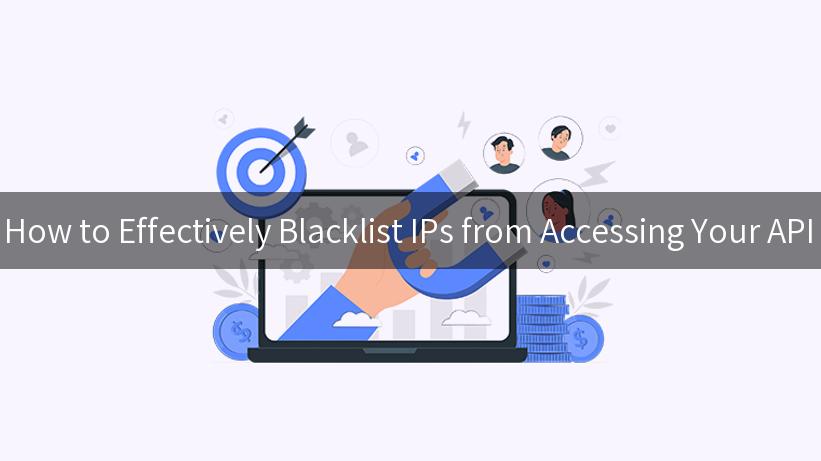
In today’s digital landscape, API security is paramount as it serves as the backbone for numerous applications and processes. An effective method for enhancing API security is by blacklisting IP addresses that pose a potential threat. This article delves into methods to effectively blacklist IPs accessing your API, discussing tools like AI Gateway, nginx, and techniques like OpenAPI and Data Encryption.
Why Blacklist IPs?
IP blacklisting is a method used to prevent specific IP addresses from accessing your API. This could be due to various reasons, including:
- Malicious Activity: IP addresses that exhibit patterns of abuse or attempts to breach security can be blacklisted to protect the API.
- Excessive Requests: Limiting the number of requests from a certain IP helps prevent Denial of Service (DoS) attacks.
- Geographical Restrictions: Some APIs may only be relevant to certain geographic areas, and blacklisting can help enforce this.
By implementing a sound strategy for blacklisting IPs, you can enhance your API’s security posture significantly.
Tools for Implementing IP Blacklisting
AI Gateway
AI Gateway is a powerful solution that includes features geared towards API security. By analyzing traffic patterns and leveraging AI, it can identify potential threats and automate the blacklisting process. AI Gateway can:
- Identify Suspicious IPs: Implement machine learning algorithms that monitor outgoing and incoming requests for suspicious behavior.
- Automated Blacklisting: Based on set parameters, the AI can automatically blacklist IPs without human intervention, enhancing response times.
nginx
Nginx is an efficient web server that can also serve as a reverse proxy, load balancer, and HTTP cache. It’s widely used for deploying APIs and supports robust IP banning features. To blacklist an IP in nginx, you can modify your configuration as follows:
http {
...
geo $deny_ip {
default 0;
192.168.1.1 1; # Example IP to block
203.0.113.5 1; # Another example
}
server {
...
if ($deny_ip) {
return 403; # Forbidden access
}
}
}
In this configuration, replace 192.168.1.1 and 203.0.113.5 with the actual IPs you wish to blacklist. This method ensures that any requests from the specified IPs receive a 403 Forbidden response.
OpenAPI
OpenAPI is a specification for building APIs. While it does not inherently include features for IP blacklisting, you can document security mechanisms effectively. Using OpenAPI, you can define security mechanisms that might apply to requests from blacklisted IPs, giving potential users insights into your access policies.
Data Encryption
Data Encryption does not directly relate to the blacklisting of IPs but is a critical part of API security. By encrypting your data:
- Data Confidentiality: Even if an attacker were to access your API, the encrypted data would be unreadable.
- Integrity Checks: Ensures that the data has not been altered during transmission.
Combining these techniques can significantly enhance the security of your API.
Summary of Tools
Here’s a summary table comparing the potential tools for implementing IP blacklisting:
| Tool |
Benefits |
Use Case |
| AI Gateway |
Automates threat detection and response |
Continuous monitoring of traffic |
| nginx |
Simple IP blacklisting configuration |
Quick setup for controlling access |
| OpenAPI |
Documentation of security policies |
Educating users about access restrictions |
| Data Encryption |
Secures data in transit |
Protecting sensitive information |
Steps to Implement IP Blacklisting
To implement an effective IP blacklisting strategy, follow these steps:
- Identify Malicious IPs: Use logs and analytics to determine which IPs exhibit suspicious behavior.
- Choose Your Tool: Decide whether to use AI Gateway, nginx, or another tool that suits your architecture.
- Configure Blacklisting: Modify your server configurations or implement automated rules to block unwanted traffic.
- Monitor and Review: Regularly review your blacklist and adjust as necessary based on changing patterns or new threats.
- Test Changes: After implementing your blacklist, conduct tests to ensure that legitimate users are not affected.
By following these steps, you ensure that your API remains secure against malicious activities while allowing genuine users to access it seamlessly.
APIPark is a high-performance AI gateway that allows you to securely access the most comprehensive LLM APIs globally on the APIPark platform, including OpenAI, Anthropic, Mistral, Llama2, Google Gemini, and more.Try APIPark now! 👇👇👇
Example: Blacklisting a Range of IPs in nginx
Continuing from the earlier nginx configuration, you might also need to blacklist an entire range of IPs. For example, if you want to block a whole subnet (e.g., 192.168.1.0/24), update your nginx configuration file as follows:
http {
...
geo $deny_ip {
default 0;
192.168.1.0/24 1; # Block whole subnet
}
server {
...
if ($deny_ip) {
return 403; # Forbidden access
}
}
}
This configuration ensures that any requests coming from IPs in the 192.168.1.0 to 192.168.1.255 range will receive a 403 Forbidden status.
Conclusion
Effectively blacklisting IPs from accessing your API is a crucial security measure that can protect your services from potential threats. Tools like AI Gateway and nginx, combined with practices such as OpenAPI documentation and data encryption, create a multi-faceted security approach. By systematically identifying malicious IPs, configuring your tools appropriately, and engaging in regular monitoring, you can ensure a safe and efficient API for all users.
In summary, can you blacklist IPs from accessing your API? Yes, you can, and it is an essential practice in maintaining a secure API environment. Implementing the discussed strategies will enhance your API’s resilience to attacks, ultimately leading to a safer experience for your end-users.